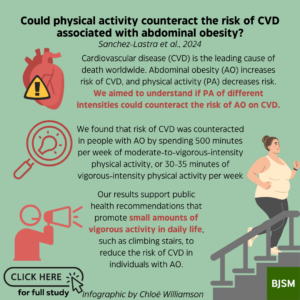Authors: Miguel Adriano Sanchez-Lastra, Ding Ding, Borja Del Pozo Cruz, Knut Eirik Dalene, Carlos Ayán, Ulf Ekelund, Jakob Tarp.
This blog provides a summary of a recently published prospective cohort study exploring joint associations of device-measured physical activity and abdominal obesity with incident cardiovascular disease.
Why is this study important?
Understanding and managing modifiable risk factors is crucial to reducing the risk of cardiovascular disease (CVD), the leading cause of death globally [1]. Abdominal obesity is a significant risk factor [2], however, weight loss is challenging for those living with obesity [3]. Thus, modifying abdominal obesity as a single risk factor is complicated. Recent studies underscore the importance of physical activity, especially of higher intensities, in reducing CVD risk [4,5]. Physical activity and obesity are believed to share mechanisms that make them (opposingly) associated with the risk of CVD [6]. In this study, we examined whether physical activity could counteract the detrimental association between abdominal obesity and CVD, and particularly the importance of more vigorous intensity.
How did the study go about this?
We analysed data from more than 70,000 individuals from the UK with an average age of 62 years and followed for about 7 years. Data included measured abdominal and total adiposity, physical activity (measured by accelerometers), and a wide range of lifestyle, health, and socioeconomic indicators. We looked at how various combinations of physical activity and abdominal obesity were associated with risk of non-fatal and fatal CVD events obtained from hospital and death records. For physical activity, we considered the total volume, as well as intensity-specific exposures; light-intensity (such as slow-paced walking), moderate-to-vigorous intensity (like brisk walking), and vigorous-intensity (such as jogging or rapidly climbing stairs).
What did the study find?
We observed that people with abdominal obesity who engaged in about 500 minutes per week of moderate-to-vigorous-intensity physical activity, or 30-35 minutes of vigorous-intensity physical activity per week, did not experience higher rates of CVD compared to those without abdominal obesity (see Figure 1).
What are the key take-home points?
Our results support public health recommendations that promote small amounts of vigorous activity in daily life, such as climbing stairs, to reduce the risk of CVD in individuals with (and without) abdominal obesity. This approach seems more efficient and probably more achievable than accumulating much higher volumes of lower intensity physical activity and may be particularly appealing to those facing time or motivation limitations for more structured exercise. This strategy can complement efforts focused on weight loss and the reduction of other CVD risk factors.
References
1 World Health Organization. Cardiovascular diseases (CVDs). 2021. https://www.who.int/news-room/fact-sheets/detail/cardiovascular-diseases-(cvds) (accessed 27 September 2022)
2 Ross R, Neeland IJ, Yamashita S, et al. Waist circumference as a vital sign in clinical practice: a Consensus Statement from the IAS and ICCR Working Group on Visceral Obesity. Nature Reviews Endocrinology 2020 16:3. 2020;16:177–89.
3 Wharton S, Lau DCW, Vallis M, et al. Obesity in adults: A clinical practice guideline. CMAJ. 2020;192:E875–91.
4 Dempsey PC, Rowlands A V., Strain T, et al. Physical activity volume, intensity, and incident cardiovascular disease. Eur Heart J. 2022;43:4789–800.
5 Ahmadi MN, Clare PJ, Katzmarzyk PT, et al. Vigorous physical activity, incident heart disease, and cancer: how little is enough? Eur Heart J. 2022;43:4801–14.
6 Thyfault JP, Bergouignan A. Exercise and metabolic health: beyond skeletal muscle. Diabetologia. 2020;63:1464–74.
